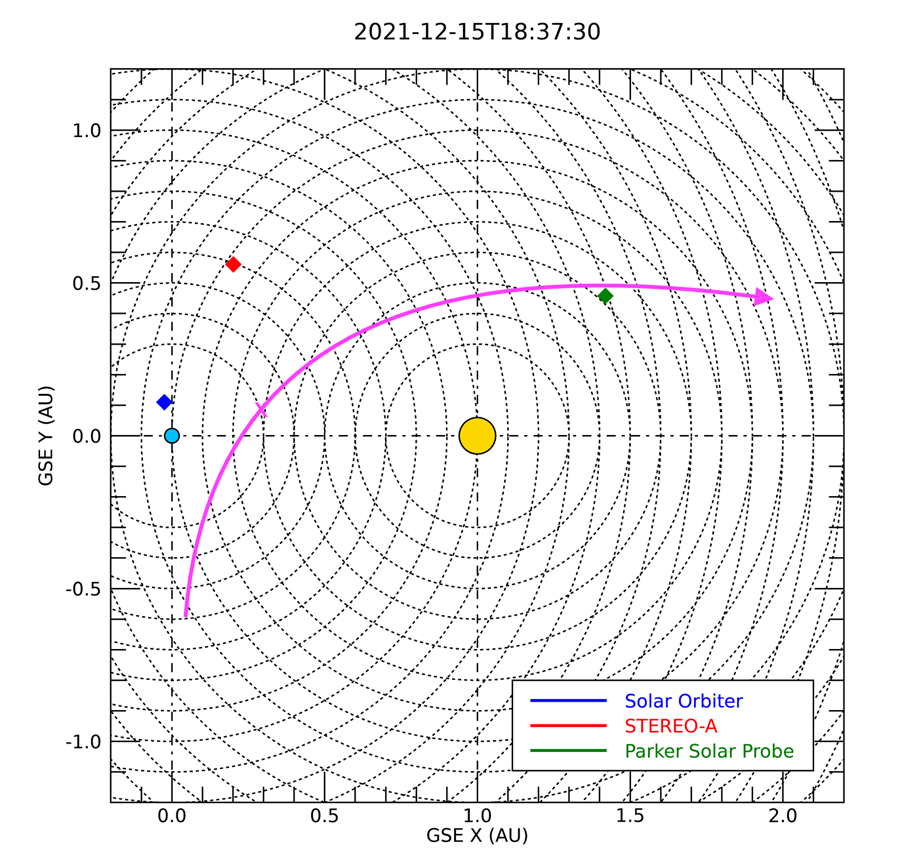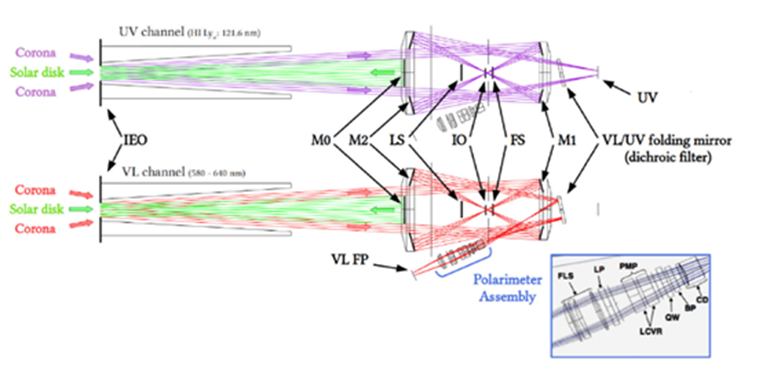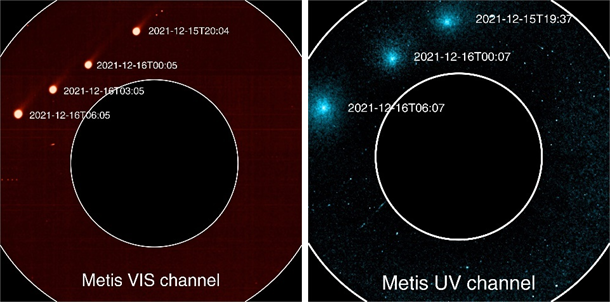- 1CNR-IFN Padova (Italy)
- 2INAF-OATo, Torino, Italy;
- 3University of Calabria, Italy;
- 4University of Firenze, Italy.
- Introduction
In the last two decades, space-based solar observatories turned out to be very suitable for comet research. Visible images taken by coronagraphs such as SOHO-LASCO C2/C3 or STEREO-SECCHI have allowed to discover and study many comets, almost all belonging to the “near-Sun comets” family [1]. Many comets have been also observed in the HI Lyman-α spectral line by the SOHO/ SWAN radiometer [2] or with the SOHO-UVCS spectrometer [3], allowing the study of their dynamical evolution of water production rates. Such observations can be of great interest also in solar physics, since a comet passing through the Sun’s corona acts as a probe to estimate the plasma parameters at each point along its path, which is a useful complement to remote sensing.
Comet C/2021 A1 (Leonard) is a long-period comet (LPC) which reached its perihelion at au on 2022 January 3. Serendipitously, the Metis coronagraph [4] onboard on ESA Solar Orbiter mission had the opportunity to perform the simultaneous imaging of this comet in linearly polarized visible light (VL) and in the ultraviolet (UV) around the HI Lyman-α (121.6 nm) spectral line, during a temporal window of about 12 hours, from 19.00UT on December 15 to 7.00UT on December 16 (see Figure 1). Such observations constitute the first-ever concurrent images of an LPC in such two spectral ranges, allowing the simultaneous study of the dust and neutral hydrogen coma.

Figure 1: Orbital configuration during the comet C/2021 A1 (Leonard) observation.
The Metis coronagraph
Metis is the coronagraph onboard SolO and it has been conceived to acquire images of the solar corona both in linearly polarized visible light (VL, 580–640 nm) and narrow-band (±10 nm) ultraviolet (UV) around the HI Lyman-a (121.6 nm) spectral line. Metis is the first coronagraph able to perform such simultaneous observations.
The instrument is designed to image the structure and dynamics of the full solar corona in an annular FoV covering the range from 1.6° to 2.9°, with 20” angular resolution in VL channel and about 80” in UV. Owing to the eccentricity of the spacecraft orbit, the heliocentric distances imaged are from 1.6 to 3.1 solar radii at minimum perihelion distance (0.28 au), up to the range from 6.0 to 12.0 solar radii when the spacecraft is around 1.0 au. A sketch of the ray trace of the two channels of the Metis coronagraph, i.e. the UV and VL, is given in Figure 2.

Figure 2: Metis layout. On the top: the UV path. On the bottom: the VL path [5].
First images
Figure 3 reports a composite image of the comet observations. Visible images were used to determine the comet brightness during the observations, monitoring the presence of an eventual outburst (or eventual outbursts), moreover, they allow to track the direction and determine the length of the comet tail. Starting from the UV image, the coma irradiance profile has been fitted by using a Haser model, as described in [6]. This allowed estimating the water production rate as well as the cometary nucleus radius. The comparison of both images gives an estimation of the hydrogen and dust coma dimension.

Figure 3: Composite image of the Metis observation of comet C/2021 A1 (Leonard). On the left: the VIS channel; on the right: the UV channel.
Conclusions
The observation of comet C/2021 A1 (Leonard) has demonstrated as Metis coronagraph on board the Solar Orbiter mission is a suitable tool for studying comets. For the first time, with Metis coronagraph, a comet has been simultaneously observed both in the visible and in the UV at the H I Lyman-α wavelengths, allowing to study at the same time both the dust and neutral hydrogen coma. For this reason, a dedicated observational program with the aim of identifying possible transits inside the instrument FoV of known or unknown comets is starting up. For instance, some sungrazing comets have been already detected in Metis images and it is under definition the observation of the periodic comet 96P/Machholz which will transit in the instrument FoV in January 2023. Finally, future observations of sungrazing comets, whether “foreseen” or ‘by chance’, will give some insights to probe the properties of the inner corona of the Sun [7].
Acknowledgments
Solar Orbiter is a space mission of international collaboration between ESA and NASA, operated by ESA. Metis was built and operated with funding from the Italian Space Agency (ASI), under contracts to the National Institute of Astrophysics (INAF) and industrial partners. Metis was built with hardware contributions from Germany (Bundesministerium für Wirtschaft und Energie through DLR), from the Czech Republic (PRODEX) and from ESA.
References
[1] Jones G.H. et al, Space Science Reviews volume 214, 20 (2018).
[2] Bertaux et al., 1995.
[3] Bemporad, A. et al., Planetary and Space Science 55(9), 1021-1030 (2007).
[4] Antonucci et al, A&A 642, A10 (2020).
[5] Fineschi, S. et al., Exp. Astron. 49, 239-263 (2020).
[6] Mancuso, S., A&A, 578, L7 (2015).
[7] Nisticò et al., ApJ, submitted.
How to cite: Corso, A. J., Da Deppo, V., Giordano, S., Mancuso, S., Nisticò, G., and Romoli, M.: Observation of comet C/2021 A1 (Leonard) with Metis coronagraph on board the Solar Orbiter mission, Europlanet Science Congress 2022, Granada, Spain, 18–23 Sep 2022, EPSC2022-901, https://doi.org/10.5194/epsc2022-901, 2022.

